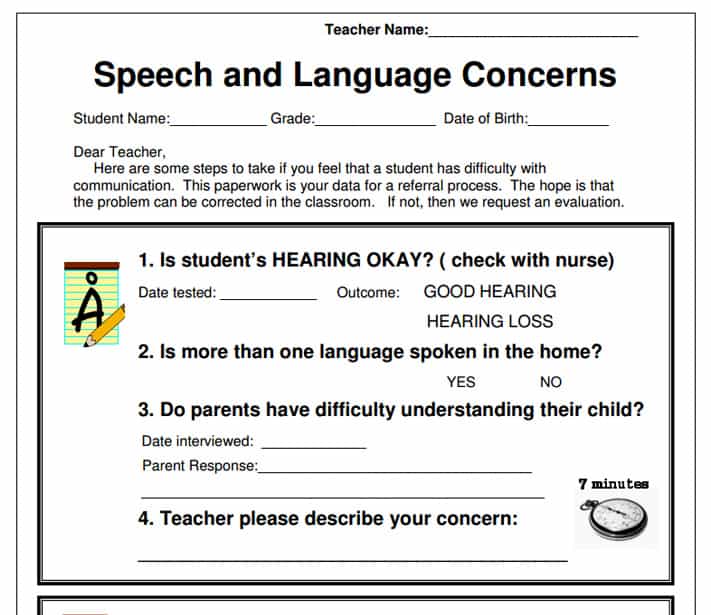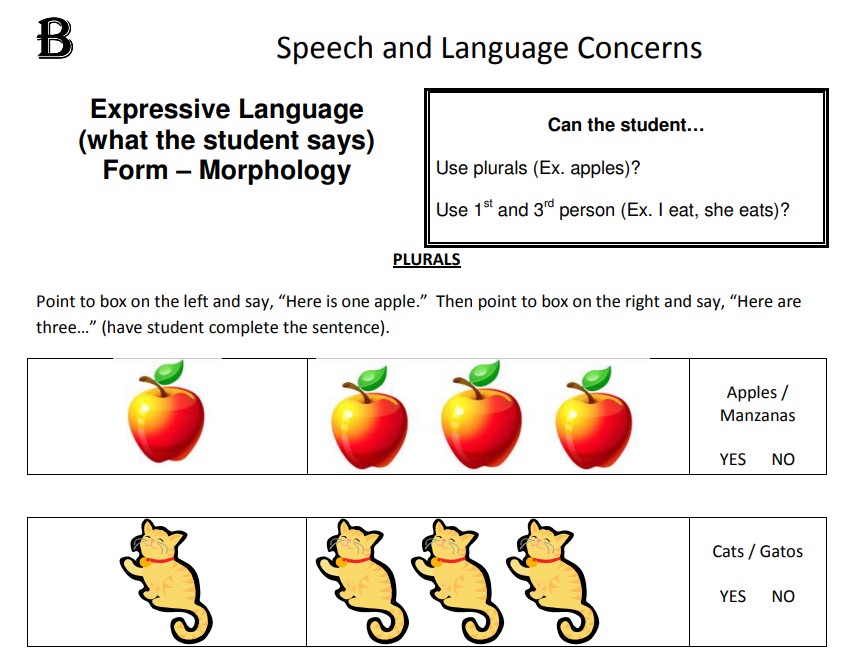School districts across the country are facing unprecedented numbers of special education evaluations. Springtime is always heavy evaluation season and this spring is particularly intense because of the impact of COVID. It’s critical that we take action so that we can reduce unnecessary evaluations for special education services.
There are two primary reasons for that the number of special education evaluations is high. First, evaluations came to a screeching halt in the spring of 2020 when everything went remote. Most school evaluators had little-to-no experience conducting remote evaluations. They were concerned about practical things, such as how to display test materials and how to see what their students were selecting, and measurement issues, such as fidelity of administration using paper tests in a remote format. (For more on these issues see ASHA article and TLD article). Second, students had reduced instruction time (NASP, 2020) and many had limited connectivity, and as a result, they’ve fallen behind. Teachers are concerned. And when teachers are concerned, they refer students for special education evaluations.
So, how do we manage the increased number of special education evaluations without killing off the speech-language pathologists, school psychologists, diagnosticians, and others who are responsible for conducting special education evaluations? Below are three ways we came up with while developing our report writer Evalubox to make an impact on the process BEFORE the consent for evaluation is signed and it’s on your plate.
Tip 1. Do a teacher in-service training on your area of expertise
Perry (2002) found that four factors strongly influenced teachers’ decisions to refer students for special education evaluations.
- Low achievement
- Behavior problems
- Poor social skills
- English proficiency
Take on the Referrals Teachers Make Solely Because of English Proficiency
Given what we know about the over-representation of children from diverse language backgrounds in special education, how can we reduce the number of unnecessary referrals we receive that cost us lots of time? Let’s tackle ONE of the big issues and help teachers to not refer students just because they are in the process of learning English as their second language.
A Student’s Level of English Proficiency Strongly Influences Referrals for Special Education Evaluations
Twenty-nine percent of teachers in Perry’s study reported that a student’s level of English proficiency strongly influenced their decision to refer student’s for special education evaluations. That’s a lot of kids who may not need a special education evaluation.
Let’s show our teachers what to look for. Show them what is typical and what isn’t. Give them tools to make good decisions. We’ve added a Teacher Inservice slide deck to our Resources Library that you can use to teach your teachers about bilingualism and what it looks like when children are acquiring more than one language.
It includes information about developmental norms for English and Spanish, Venn diagrams that compare and contrast English and Spanish, and some common language patterns for children learning both Spanish and English. You can customize the slides to work for your school population.
Request 20 minutes at the next campus meeting. You’ll be repaid those 20 minutes in spades when you avoid even one unnecessary referral for a speech evaluation.
Tip 2. Provide a Speech-Language Referral Packet that Works for You and Your Teachers
When teachers want to make a referral for a special education evaluation they have a lot of hoops to jump through. One of the first hoops is to provide the specifics about their area(s) of concern. They complete loads of forms that attempt to hone in on whether they are concerned about syntax, morphology, phonology, pragmatics, receptive language, expressive language, fluency, voice, etc. I can’t tell you the number of times teachers have told me that the forms are overwhelming and they aren’t always sure what information the forms are asking for.
Just Check These Boxes to Get a Special Education Evaluation
One of my favorite stories was when one of the Bilinguistics SLPs was eating lunch in the Teacher’s Lounge at an elementary school. She ended up at a table with two teachers talking about how to get a student tested for speech. One teacher said to the other, “Let me see that form. Here’s what you need to check to get the evaluation.” She proceeded to check all of the “rarely,” “never,” and “below average” boxes. And to be fair to the teachers, their referral packet was just shy of 50 pages long. With a classroom of 22 students and lessons to plan and assignments to grade, can we really blame them for taking a short cut to get help for their students?
The Teacher-Friendly Referral Packet for Speech and Language Concerns
It was stories like these that inspired my colleague, Scott Prath, to develop a friendly speech-language referral packet for teachers. It’s an interactive PDF that is short and sweet. It guides teachers through the information they need to collect and gives them examples along the way.
It starts with an easy 4-page form that uses teacher-friendly language (read: non SLP jargon) to help teachers identify the area of concern. And it tells the teacher up front that it will only take the 7 minutes to complete the initial section.
From there, it takes the teacher to a single page form for each area of concern. If a teacher is concerned about a child who omitting sounds at the beginning of words, they go to this form.

If, for example, they are concerned about their student’s use of plurals, they’ll be taken to this form.

These forms help us to quickly work with with teachers to get information that will help us decide whether an evaluation is needed. And if we’re on the fence about whether an evaluation is truly needed, we can go a step further.
Tip 3. Collaborate with Your Teachers on Referrals for Special Education Evaluations
I recently did a workshop where I talked about Dynamic Assessment as a tool in our evaluator tool boxes. It is a test-teach-retest paradigm we use to rule out lack of experience or lack of understanding of the task. One of the participants asked this question.
Could dynamic assessment be done before an evaluation for special education?
Hmmmm? Teach and look at what students learn—that sounds like Response to Intervention (RTI), doesn’t it?
What is Response to Intervention (RTI)?
Response to Intervention (RTI), also referred to as Multi-Tiered Systems of Support (MTSS) is a process that has been used in schools to reduce over-referrals for special education. In my time in the field I have watched schools go from no RTI process to extensive ones to abandoning the process altogether. It varies by state and by districts within states as to policies about the Response to Intervention process.
What is the Relationship Between RTI and Dynamic Assessment?
To answer the question, looking at students’ response to Intervention is exactly what we are looking at in Dynamic Assessment. Response to intervention is to general education what dynamic assessment is to special education. It’s a general education initiative to see how students respond to different levels of instruction. Those who respond well to instruction don’t proceed to the evaluation and those who show limited responsiveness do proceed to the evaluation.
Why isn’t RTI used consistently to reduce unnecessary referrals for special education?
One problem is that studies have shown that RTI is not effective. A large-scale study published in 2015 found that RTI negatively impacted the academic achievement of first graders and had no impact at all on second and third graders. Since then, further studies have found that in many of the schools included in the large-scale study mentioned above, RTI had been largely abandoned or not used properly
Why have some schools abandoned the RtI process?
Some of the RTI processes were just too complicated. Teachers had 300-page books that they were asked to use to prior to making a referral.
Why was RTI not used properly?
What is comes down to is that there was not enough training. We can’t just throw a program at teachers and say, “Use it.” It has to come with training. Many teachers reported they simply didn’t have enough (if any) training on how to properly implement RTI.
What are the Elements of RTI and Dynamic Assessment that are important in Decision Making?
The goal of both RTI and Dynamic Assessment is to reduce bias. We do this by not assuming that students walk into the classroom with certain skills, experiences, and knowledge. We teach them the skill in question and see how well they learned it. We’re looking at learning potential. How easily do they grasp the concept or the information we are sharing? That’s the information we need.
How Do We Help Classroom Teachers Refer the Right Students for Speech-Language Evaluations?
We collaborate. We listen to the teachers concerns. We consider the impact of bilingualism for students exposed to more than one language. We share developmental norms. We share techniques for helping children produce sounds or phrases or complex sentences. We give teachers quick and easy ways to evaluate changes.
Share Research about Examiner Effort
Lidz’s research on dynamic assessment indicated that ratings of examiner effort most highly correlated with whether a student demonstrated a disorder or not. This is important information for teachers to know. If they consistently have to put in loads of effort (multiple repetitions, hand-over-hand modeling, demonstrations, modifying the tasks,…) to help a child be successful, that student is a great candidate for a special education evaluation. If their effort is minimal to impact change and learning, that student is likely not a great candidate for a special education evaluation.
Why can’t special education evaluators just do the RTI themselves?
In some districts, special education personnel are very involved in the RTI process. In others, they are not at all involved. There are many legal disputes about how involved special education professionals can and should be in the RTI process. That’s beyond the scope of this article but I’ll leave you with three thoughts here:
- There’s no law against teachers and special educators collaborating.
- In order to conduct a special education evaluation, we need consent from parents.
- Once that consent has been signed, we’re doing a Full and Individual Evaluation.
So, jump in there and help the teachers get the information they need to make an informed decision about whether they should refer their student for an evaluation. I encourage collaboration at the early stages so that unnecessary evaluations can be avoided.









I love the language Venn diagrams for Spanish, Mandarin, and Vietnamese. Do you have any premade for Hmong? It is a wonderful visual. Also, I will be printing out the teacher referral info on Monday morning! Thank you!
Yes, we do have one for Hmong. It’s in the blog post Hmong Speech and Language Development. Glad you liked the Venn diagrams in the Teacher Training Slides and the teacher-friendly referral packet.